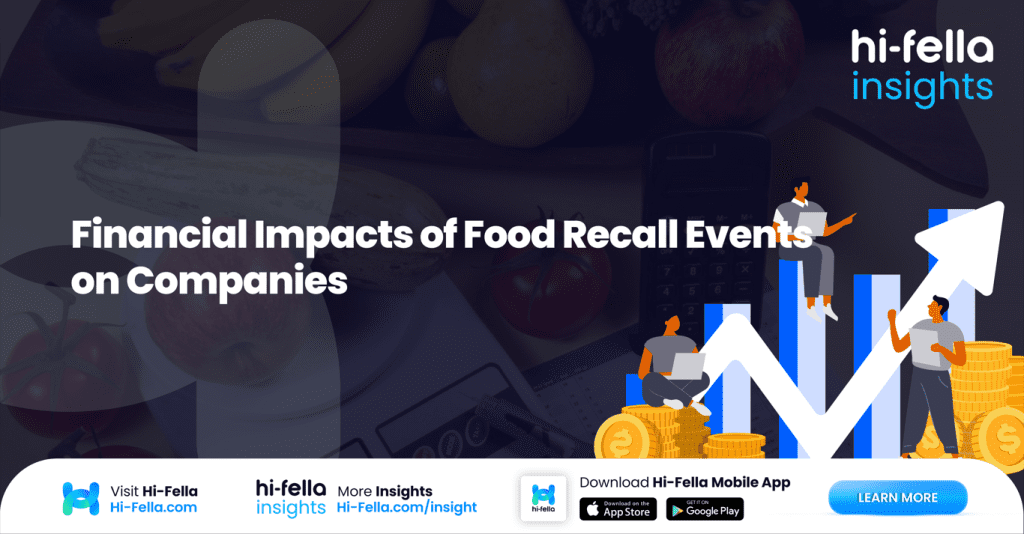No food company wants to see its product pulled from shelves—but recalls happen. And when they do, the financial impact hits fast and deep. Whether it’s due to contamination, mislabelling, or undeclared allergens, food recalls are among the costliest risks in the industry. They don’t just affect the bottom line—they ripple across operations, logistics, legal departments, brand reputation, and future growth.
For businesses operating in export markets or through complex supply chains, the stakes are even higher. Let’s unpack the real financial implications of food recall events—and why prevention, traceability, and response planning should be treated as core business strategies, not afterthoughts.
The Immediate Direct Costs: Recalls Are Not Cheap
The moment a food recall is triggered, companies enter what is essentially an emergency response mode—except the consequences aren’t just health-related, they’re financially severe and logistically complex. The first wave of impact typically comes in the form of direct operational costs, which escalate quickly, especially for businesses with broad distribution.
One of the most immediate actions is product withdrawal—physically removing items from shelves across supermarkets, distribution centres, and foodservice outlets. This requires coordination with retail partners, third-party logistics providers, and in some cases, direct notification to end consumers. If the product has already been exported, costs rise significantly due to international shipping, customs coordination, and re-import fees.
Next comes the shutdown of production lines. While the issue is being investigated, companies often suspend operations for that specific product line, especially if the root cause hasn’t been isolated. That downtime costs money—both in lost output and idle labour. In multi-line factories, this can also disrupt other SKUs, leading to broader production inefficiencies.
Then there’s the cost of investigation and testing. This includes sending samples to accredited labs, working with food safety consultants, performing root cause analyses, and coordinating with local or national food authorities. Companies may need to run multiple tests across product lots, production dates, and packaging formats—each with its own expense. In larger recalls, this stage alone can consume tens of thousands of dollars.
On top of that, legal and compliance costs begin to stack. Companies typically need to engage legal counsel to manage risk exposure, draft official statements, prepare for possible litigation, and navigate any regulatory inquiries. If the problem can be traced back to a third-party supplier—such as a contaminated spice mix or faulty packaging—there may be complex negotiations around liability sharing or financial compensation to downstream partners or retailers.
Let’s not forget logistics rework and product disposal. Recalled items have to be collected, documented, transported (often under controlled conditions), and either destroyed or reprocessed according to safety regulations. Depending on the volume and type of food product, this can incur hazardous material disposal fees, storage costs for quarantined stock, and administrative overhead for traceability documentation. In highly regulated markets like the U.S. (FDA) or EU (EFSA), failure to comply with recall procedures can trigger fines, suspensions, or import/export bans, further amplifying the financial damage.
Even a recall that affects just one product variant or distribution region can drain weeks of internal resources—from quality control and operations to finance, legal, and communications teams. Staff hours are redirected away from growth projects, R&D, or export expansion, and focused entirely on recall response, reporting, and remediation.
The real kicker? None of these costs are optional. They’re the baseline response required to mitigate greater risks—like public health consequences, lawsuits, or regulatory shutdowns. That’s why many food manufacturers treat recall preparedness as a financial insurance policy in itself. Prevention is cheaper than reaction, and when the stakes are this high, speed, coordination, and clarity are everything.
So if you’re producing for national chains or shipping your food products globally, it’s not just about what you make—it’s about how fast you can pull it back if needed. And that starts with having systems, partners, and a traceability backbone that can handle the pressure. Platforms like hi-fella can help by connecting you with traceable, compliant suppliers and export-ready networks that strengthen your risk management from day one.
The Hidden Long-Tail Costs: Brand, Trust, and Shelf Space
Beyond the obvious, there are long-tail financial consequences that last long after the recall dust settles. Chief among them is brand damage. A single recall can shake consumer trust—especially if it involves vulnerable categories like infant food, dairy, or ready-to-eat meals.
Once brand confidence takes a hit, retailers may reduce shelf space, limit future listings, or shift promotional budgets away from your products. Export partners may reconsider their agreements or place stricter requirements on your next shipments. Insurance premiums may rise. Investors get nervous.
Recovering from this erosion of goodwill can take years, and it often requires substantial investment in marketing, PR, and quality assurance to rebuild what was lost. That’s a sunk cost that doesn’t show up on your recall invoice—but it hits where it hurts: future revenue.
Legal Liability and Insurance: Not Always a Safety Net
You might assume your product liability insurance will cover the damage—but it’s rarely that simple. Insurance claims for recalls can be delayed, disputed, or capped, especially if negligence is found or if the issue traces back to a subcontractor or raw material supplier.
In some jurisdictions, strict liability laws mean companies are responsible even if the contamination occurred earlier in the supply chain. That means you may end up paying the bill for someone else’s mistake—unless your contracts, traceability, and risk management practices are airtight.
Some businesses also discover too late that their policies don’t cover things like reputational harm, cancelled export orders, or business interruption. That’s why financial planning for recalls should include legal audits and robust contract structures with all upstream and downstream partners.
Export Market Implications: One Recall, Multiple Markets
For exporters, a single recall incident can have multi-market fallout. Different countries have different food safety laws, reporting systems, and tolerance thresholds. What’s acceptable in one market may be banned in another.
If your product is recalled in a major market—say the EU, U.S., or Japan—your export certifications may be suspended, and your goods flagged for higher scrutiny at borders. This slows down your logistics, disrupts supply chains, and may result in customs delays, added testing fees, or full shipment rejections.
In some cases, governments issue public notices that remain searchable online for years—affecting buyer confidence and future procurement decisions. Exporters without contingency plans, reliable batch traceability, or third-party audit trails risk losing their most valuable markets over a single issue.
Prevention is Cheaper Than Crisis Management
The most effective way to minimise the financial impact of recalls is to prevent them in the first place. That means investing in food safety systems, training staff, auditing suppliers, and implementing traceability tools that allow for rapid, targeted responses when something goes wrong.
For example, companies that use batch-level traceability systems (including blockchain-based solutions) can often isolate affected products within hours—minimising the recall scope and showing regulators they’re on top of the issue. That kind of agility can reduce costs, protect brand integrity, and even turn a crisis into a case study for operational excellence.
Think of it this way: a robust prevention strategy might cost you 1–3% of revenue. A full-scale recall could cost 10–30%—or worse, derail your entire export business. That’s not risk management. That’s basic financial sense.
Scale, Complexity, and the Risk Multiplier
The more complex your supply chain, the greater your recall exposure. Companies sourcing ingredients globally, processing in multiple plants, or co-packing under private labels face exponentially more risk.
And while larger businesses have more resources to weather the storm, smaller brands are often hit the hardest. One incident—especially early in their growth trajectory—can drain capital, ruin retail relationships, or push them out of a market entirely. That’s why even SMEs should treat recall risk as a financial planning priority, not just a compliance checkbox.
Platforms and trade partners that understand this complexity can make a big difference—especially for brands entering new export markets or exhibiting at global trade shows where reputational stakes are high.
Partnering with the Right Platforms: Why hi-fella Matters
If you’re trading across borders, exhibiting your products globally, or building retail relationships in compliance-heavy regions, you need more than logistics—you need strategy.
hi-fella is your export-import platform built for food businesses ready to scale smartly and protect their reputation. Whether you’re showcasing at international exhibitions, preparing for certification audits, or looking for traceable sourcing solutions, hi-fella connects you with the right partners, buyers, and support systems to trade safely and confidently.
It’s not just about exposure—it’s about resilience, compliance, and peace of mind in a high-stakes industry.
Food Recalls Are Expensive—but They’re Not Inevitable
In the modern food industry, recalls are a fact of life—but they don’t have to be a death sentence for your business. With the right systems, partners, and foresight, companies can reduce the likelihood, limit the scope, and contain the financial impact of a recall event.
It all comes down to preparation, not panic. And when you’re ready to grow your business with confidence—at home or abroad—hi-fella is the platform built to support your trade, your trust, and your long-term value.








